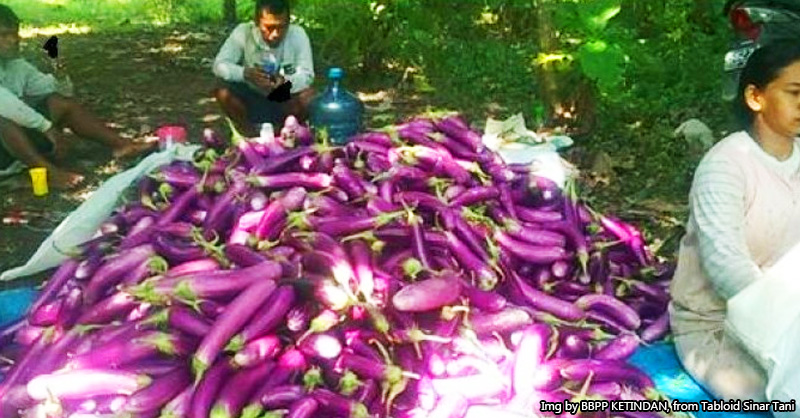5 juicy terung facts to read when you’re murung

- 92Shares
- Facebook73
- Twitter4
- LinkedIn4
- Email5
- WhatsApp6
Happy Terung 🍆 Appreciation Day everyone! 🍆🍆🍆🍆🍆🥳🥳🥳🎉🎉

Well, not really. World Eggplant 🍆 Day seems to actually be on the 17th of August every year, but we simply can’t wait, for we at Cilisos adore this divine 🍆 so much. So very much. How we weep for joy at its bountiful length! How we prostrate ourselves in reverence of its turgid girth! And how… *sheds a single tear of bliss* how we hunger at the thought of its purple skin, shiny under a coating of curry or sambal, lightly grazing our teeth as we stretch our lips around it!
Indeed, our love for this fruit is almost sinful, and in our joy we’d like to share 5 (🍆🍆🍆🍆🍆) interesting facts about the eggplant, sure to deliver you to our 🍆 cult. Starting with…
1. Common terung 🍆 names come from their tendency to make you 💨💨
Scientifically called Solanum melongena, this is a fruit with many names. The word ‘terung‘ seems to be an original Malay/Javanese word, as far as we can tell, but people over the globe had been calling it various things.

The most popular names for it are aubergine and brinjal, and these can be traced back to the Arabic al-badinjan, which was itself a loanword with Sanskrit origins: vatigagama, meaning ‘the plant that cures the wind‘, since it was believed that eating terungs can rid you of gas. Aubergine is more commonly used in British English, French, Dutch, and German; while brinjal is more common South Asia and South Africa, and to some extent, Malaysia and Singapore.
In places like North America and Australia, the term eggplant is more common, because angmohs saw the small white one first. And we don’t blame them for calling it an eggplant. Enjoy this lulzy portrait we found on the Wikipedia page:

Grown in gardens, it was also known as the garden egg at the time. When a similar-looking but longer and purpler fruit came along, they just called that the eggplant as well. And such was the tale of the terung’s hubris.
2. We have long 🥵 terungs, hairy 🌵 terungs, and tiny 🤏 terungs
As is the case with many agricultural produce, there are several varieties of terung out there. The girthy terung we know and love (Solanum melongena) are usually known as terung panjang (long terung), and it’s the most common cultivar being planted in Malaysia. Other varieties of this type include the terung putih panjang (long white terung), which is like the regular terung but white; terung bulat (round terung), which is round as its name implies; terung rapuh (brittle terung), which is slightly ovoid and has a crunchy flesh; and terung telur (egg terung), which is white and resemble an egg.

Members of a close species called Solanum ferox are also called terungs, and there are two common varieties. One of them is the terung Dayak (or terung asam), which is round, orange-ish and sour, and more popular in Sarawak. The other one is the terung bulu (hairy terung), which looks the same but is covered with a fine hair. This variety is more commonly found wild, although it had been grown in small-scale farms. The flesh has a sweet-sour taste, and it’s used in curries and sauces, and as medicinal preparations for worms, minor injuries, or even syphilis.
Finally, there’s the terung pipit (Solanum tarvum), which looks quite far from a regular terung: tiny, green, and grows in bunches. The name is kinda cute since pipit are small birds, and this terung’s size make it seem like it’s terung, but for pipits. Anyway, this kind of terung can be found near houses and farms, and the fruits are eaten as a salad or a sambal.

Anyhow, if you want to read up more on the different types of terung out there, we recommend this blog written by a local agronomist expert: it’s quite comprehensive. But regardless of which type of terung you have a preference for, it’s important for us to remember that all terungs are equally valid💯💯💯.
3. You can take a ride 🤠 on a terung 🍆. Yeehaw!

Well, kinda. For the purposes of this section, you’ll have to be a Japanese spirit to actually ride one. During the Obon festival, which is kinda like the Japanese Buddhist equivalent of the Qing Ming festival, ancestors’ graves are cleaned, and their spirits are supposed to visit their families’ household altars. On some of these altars, you might find two curious things: a cucumber and a terung, both standing on four wooden ‘legs’.
These are vehicles for the ancestral spirits. The cucumbers are meant to be horses that swiftly carry the ancestors home from the underworld. The terung, on the other hand, is meant to be a cow: sturdier so that it can help carry the offerings back to the underworld, and slower so that the spirit can enjoy a leisurely return. Sounds like we made that up, but the cucumber and terung horses made it as seasonal items in Animal Crossing: New Horizons last year.

While most of our readers probably don’t celebrate Obon, a terung cow is pretty cute and easy to make, so feel free to make one and pretend that it’s a real cow! Make it moo! Taunt it with a red cape! Don’t forget to use the terung for lunch after you’re done playing with it. We don’t waste.
4. Terungs🍆 are related to potatoes🥔, tomatoes🍅, and… tobacco🚬?!
Terungs belong to a family of plants called Solanaceae, or commonly known as nightshades. If the name sounds a bit ominous, it’s probably because you’ve heard of a plant in this family called the deadly nightshade (Atropa belladonna), which is highly toxic. But not all nightshades are harmful, they just make some fascinating chemicals. Members of the family include fleshy bois like tomatoes and potatoes, spicy bois like chili peppers, ornamental bois like the petunia, and even smoky bois like tobacco.

So the family is pretty diverse, but it’s interesting to note that the terung’s relationship with tobacco isn’t just as a stepbrother: terung seeds also contain trace amounts of nicotine, giving them that slightly bitter taste. While a host of other fruits and vegetables like potatoes, tomatoes, celery, and cauliflower also contain small amounts of nicotine, terungs have the highest nicotine content among all of them. Even so, you shouldn’t worry about getting addicted and wanting to have a terung in your mouth every time you’re stressed. You’d have to eat over 9 kilos of terungs to get roughly the same nicotine from a single cigarette.
So unless your terung-mania is greater than ours, there’s no need to prepare for terung withdrawal symptoms anytime soon.
5. Is your terung 🍆 big enough 🥵 to sell 💹💹💹?

What makes a BIG terung? The Malaysian Federal Agricultural Marketing Authority (FAMA) had published a guide for farmers to sell their terungs, and within it is a guide to classify your terungs based on size and weight. So whip out your rulers and weighing scales, and let’s measure your terung!
- To be considered as XL (extra large/terlalu besar/daddy terung), your terung will have to be longer than 30 cms (11.8 inches) and weigh more than 300 grams.
- If your terung is between 21-30 cms long (8.3-11.8 inches) and weigh between 201-300 grams, it’s considered an L (besar/large).
- If your terung is between 11-20 cms long (4.3-8.2 inches) and weigh between 101-200 grams, it’s an M (medium/sedang).
- Your terung is S (smol/kecil) if it measures less than 10 cms (below 3.9 inches) and weigh less than 100 grams.
Well, you know what they say. When it comes to making a tasty terung dish, it’s not the size of the terung, but rather how you cook it.
All 🍆 hail 🍆 the 🍆 purple 🍆 fruit!
Well, that’s it for our article today. There’s so much more we’d like to say about the terung (did you know that it’s technically a berry?), but we hope that with these interesting facts out in the open, it will widen our knowledge of this magnificent fruit, fill up the holes in our understanding of it, and deepen our validation and veneration for this versatile veggie. Be it soaked in curry, stuffed with sambal, or slathered in oil, let us take a moment of silence and appreciation the next time we bite into a terung before letting it slide down our willing throats.
Glory to the terung, and may your days be filled with them.
- 92Shares
- Facebook73
- Twitter4
- LinkedIn4
- Email5
- WhatsApp6
